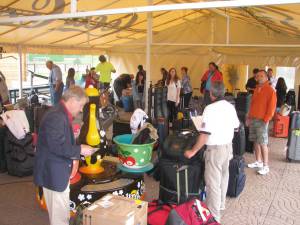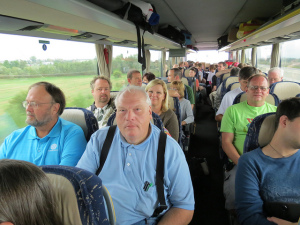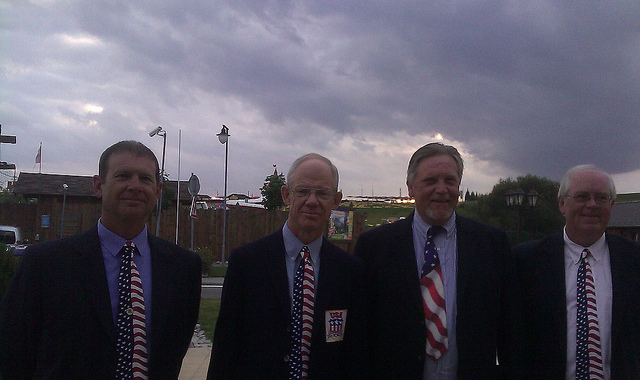Traveling and Operating Overseas
Participating in a World Spacemodeling Championships as a member or supporter of the US Team is a memorable experience. A WSMC is closer to the Olympics in its protocols and pressures than it is to an NAR contest. US Team members wear team uniforms, operate as a full team representing the USA and supporting each other in rocket-flying, culturally, and in behavior and sportsmanship. Team members are together at least 16 hours per day for 8 days in a foreign country, eating every meal together and traveling to and from the flying field as a single group. While the NAR and one corporate sponsor (Estes) provide financial support for some things such as equipment, uniforms, and motors, the basic travel and lodging cost of about $2500 per person is paid by each individual on the team. Juniors get a $1000 travel grant when the WSMC is held overseas, and get their hotel and meal costs of about $600 regardless of where it is held paid courtesy of financial grants from the NAR and Estes, so their net cost is less.
Airline travel to a WSMC is generally not done as a single-group operation. Each team member has their own starting point in the US, pre-or-post event touring plans, frequent flier miles, etc. People operate independently for arranging their air travel. Generally there is an agreement to all arrive at a specific airport near the event site on a specific date (the official “arrival” date on the WSMC event schedule) and to take a group chartered bus from there to the city and hotel designated by the WSMC organizers. Then there is a chartered bus back to that airport on the designated “departure” day on the WSMC event schedule. Keep in mind in your travel planning that every airline connection is a fresh opportunity for an airline to lose luggage (i.e. the models that are your reason for travelling), so planning the trip to the WSMC to have the fewest possible connections and layovers, with generous amounts of time for luggage as well as people to make any connections, is prudent. Bags are lost nearly 100% of the time with a connection in Paris Charles DeGaulle Airport, so connections through here should be avoided. Lost models on a return trip that involves touring and connecting flights do not matter so much.
When you are at a World Spacemodeling Championships in East Europe, if you need something there is usually no convenient store to go to in order to buy it. Finding food and drink at a local market near the hotel is generally not an issue (although it may be on flying days when you leave the hotel at 7 AM and return at 9 PM), but if you have special dietary needs bring appropriate specialty foods and of course bring an adequate supply of any medications you need. The meals provided at the event are typically one-size-fits-all, with minimal menu choices (sometimes there is a vegetarian option) and no drinks of any kind provided except bad coffee at breakfast. If you are a picky eater, you may need to bring supplementary food. Generously-sized hot box lunches are provided on the flying field, and there is always a food and drink vendor there as well. The hotels are usually pretty austere, and toiletries such as soap or shampoo are often not part of what is provided in the rooms, nor are alarm clocks. All rooms are two-bed doubles; everyone has a roommate. Even austere East European hotels these days seem to have WiFi, but it often does not extend past the lobby area or gets overloaded by the number of rocketeers using it. Cell phone providers offer overseas data, text, and/or voice roaming plans for reasonable prices as a backup. Remember that Europeans use 220 V/50 Hz electric power with a different type of plug, so bring converters and adapters for power equipment.
Typically each team member brings their own preferred launch device (tower, piston, etc.) and portable electrical launch system as the event organizers do not provide either of these. There are opportunities here for sharing of common equipment within the team, but this is often not well-coordinated in advance. The team needs and uses many FRS/GMRS radios for recovery coordination, and several sets of thermal-detection equipment such as tripod-mounted Kestrel weather stations and 20-foot extendable poles with thermal streamers, so it is important to coordinate in advance of departure who is bringing how many of these.
The end-of-meet awards banquet is a surprisingly dressy affair for a rocketry event. You should bring a jacket and tie or equivalent female attire for this. Also bring pins, decals, and other give-aways as everyone there from other countries will probably be carrying such things looking to trade souvenirs. If the US Team wants table decorations (US table flags, etc.), plan ahead and bring these as well. Adults should consider bringing ear plugs (!!), as the custom is to have extremely loud rock bands to support dancing into the late night by the young (or young at heart) rocketeers.
The daily routine at a WSMC involves an early-morning departure for the flying field and late-evening return. It is expected that every team member will go to the field every day, even if not flying that day, in order to help the team with recovery or whatever else needs doing. People flying in a day’s events wear the full team uniform (team shirt, hat, and jacket). Those who will be on recovery should wear sturdy shoes (boots) and long pants; people who wear shorts on recovery usually return bleeding. Most participants use the common buses provided by the event organizers, although sometimes the large US Team rents a private bus for their exclusive use. The buses run from hotel to field once in the morning and back once in the evening, and the distances are generally large, so it is important to plan and pack carefully what you take with you each day to the flying field; if you are competing that day be ready to fly and to repair any conceivable damage to the models that you are flying. For the tools and supplies to complete assembly, prepping, repair, and flying of your models, take everything you think you might need, or make sure that one of your teammates is taking it and is OK with your borrowing if needed. There will be no hobby stores or on-field rocketry vendors. Every flier on the team should take all of their “stuff” to the field every day, even if they are not flying their own event that day, in order to be able to support teammates who are flying. It is usually a long way between where the buses park and where the tents (with tables and chairs) are located that are provided for each team by the meet organizers, so it is important that you have all your gear in wheeled cases (such as Pelican cases or a hard case made for a bag of golf clubs) or small ones, as you will be carrying all of your stuff yourself. Several team members rent automobiles, which is handy for long-distance recovery or for emergency mid-day shuttling between hotel and field. Always bring your U.S. team jacket to the field, and a flashlight. It can get surprisingly cold waiting for the end-of-the-day awards ceremony and you will need a jacket; and these ceremonies usually end after dark so a flashlight will be useful to find your gear in the team tent, and maybe to light your way to the team bus.
What I Got From Attending the World Space Modeling Championships
by Tim Van Milligan / Apogee Rockets
Did you ever think you could travel to another country to fly rockets? A few weeks ago, I got that chance. In this newsletter, I’ll fill you in on what I got out of that trip. This was my first excursion overseas, so I didn’t know what to expect, and I wasn’t disappointed. You can download issue 373 at: https://www.apogeerockets.com/Education/Downloads/Newsletter373.pdf
Take a photo of each item of your checked luggage on your phone before you leave your house. When the airline loses your luggage (and they probably will, particularly if your go through Paris), they’ll ask you what the missing item looks like. Then you can whip out your phone and point to the picture.
Hard-back carry-on luggage can be purchased at Walmart for between $50 and $60 per case. It is sized so that it fits within the airlines’ strictly-enforced dimensional guidelines for carry-on luggage (which are typically 21 x 14 x9 inches, different and more strict than in many domestic US flights; check the regulations for your particular airline at https://travel-made-simple.com/carry-on-size-chart/ . If you have a lot of models, leave
the fins off so you can get more into each case. You’ll also have to leave the nose cones off too.
The standard body will just barely fit into the length of the case.
Related Documents:
| Traveling with Models (AMA June 2018) | January 19, 2020, 2:50 am | 1 MB |






